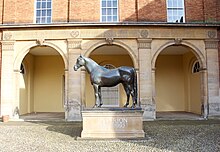Jockey Club Racecourses

The Jockey Club Rooms in Newmarket, UK
|
|
| Private incorporated by Royal Charter | |
| Industry | Horse racing, Leisure |
| Founded | 1750 |
| Headquarters | 75 High Holborn, London |
|
Area served
|
United Kingdom |
| Revenue | £150.3m (2012) |
|
Number of employees
|
circa 500 FTE |
| Divisions | Jockey Club Racecourses, Jockey Club Estates, The National Stud, Racing Welfare |
| Website | www |
The Jockey Club is the largest commercial horse racing organisation in the United Kingdom. No longer responsible for the governance and regulation of British horseracing, today it owns 15 of Britain's famous racecourses, including Aintree, Cheltenham, Epsom Downs and both the Rowley Mile and July Course in Newmarket, amongst other concerns such as the National Stud, and the property and land management company, Jockey Club Estates. The registered charity Racing Welfare is also a company limited by guarantee with the Jockey Club being the sole member. As it is governed by Royal Charter, all profits it makes are reinvested back into the sport.
Formerly the regulator for the sport, the Jockey Club's responsibilities were transferred to the Horseracing Regulatory Authority (now the British Horseracing Authority) in 2006.
The Jockey Club has long been thought to have been founded in 1750 – a year recognised by the club itself in its own records. Some claim it was created earlier, in the 1720s, while others suggest it may have existed in the first decade of the century.
It was founded as one of the most exclusive high society social clubs in the United Kingdom, sharing some of the functions of a gentleman's club such as high-level socialising. It was called 'The Jockey Club' in reference to the late medieval word for 'horsemen', pronounced 'yachey', and spelt 'Eachaidhe' in Gaelic. The club's first meetings were held at the "Star and Garter" tavern in Pall Mall, London, before later moving to Newmarket; a town known in the United Kingdom as "The Home of Racing". It was historically the dominant organisation in British horseracing, and it remained responsible for its day-to-day regulation until April 2006.
...
Wikipedia
